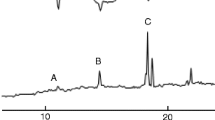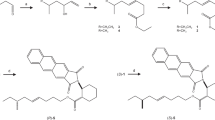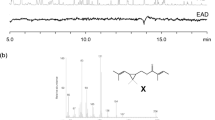Abstract
The fifth abdominal segment of femaleEriocrania semipurpurella (Stephens) andE. sangii (Wood) contains a pair of exocrine glands. Hexane extracts of this segment were prepared from both species and analyzed by gas chromatography with simultaneous flame ionization and electroantennographic detection (EAD). For both species, the EAD active peaks were identified as nonan-2-one, (Z)-6-nonen-2-one, and (Z)-6-nonen-2-ol by means of mass spectrometry and comparison of retention indices with those of synthetic standards. Enantiomeric separation of chiral alcohols from the female extracts was achieved by gas chromatographic analysis on a cyclodextrin column. InE. semipurpurella, a mixture of (2S,6Z)-nonen-2-ol and (2R,6Z)-nonen-2-ol (2: I) was found, whereas inE. sangii (2S,6Z)-nonen-2-ol was the predominant enantiomer and only traces of theR enantiomer were indicated by the antennal response. In field tests, a blend of the three compounds was not attractive to conspecific males. A subtractive assay showed that the alcohol in various enantiomeric mixtures was the only attractive compound, whereas addition of (Z)-6-nonen-2-one to the alcohol completely inhibited the attraction of both species. A trapping experiment including a wide range of ratios between theR andS enantiomers showed that baits containing 95–100% of theS enantiomer were attractive to maleE. sangii, whereas males ofE. semipurpurella were attracted to all tested ratios of the enantiomers. However, the response profiles of maleE. semipurpurella differed between populations from southern Sweden, south Finland, and the Kola Peninsula in Russia. In south Sweden males were maximally attracted to a racemic mixture of the alcohols. At the Kola PeninsulaE. semipurpurella was attracted to baits containing 95–100% of theR enantiomer. In south Finland all tested ratios between 0 and 100%R enantiomer trappedE. semipurpurella, but the trap catches appeared to be bimodally distributed with peaks around 15 and 70%R enantiomer. The trapping results suggest the existence of pheromone races or sibling species among the specimens identified asE. semipurpurella.
Similar content being viewed by others
References
Anderbrant, O., Löfqvist, J., Jönsson, J., andMarling, E. 1989. Effects of pheromone trap type, position and colour on the catch of the pine sawflyNeodiprion sertifer (Geoff.) (Hym., Diprionidae).J. Appl. Entomol. 107:365–369.
Arn, H., Esbjerg, P., Bues, R., Tóth, M., Szöcs, G., Guerin, P., andRauscher, S. 1983. Field attraction ofAgrotis segetum males in four European countries to mixtures containing three homologous acetates.J. Chem. Ecol. 9:267–276.
Arn, H., Tóth, M., andPriesner, E. 1992. List of sex pheromones of Lepidoptera and related attractants. OILB-SROP, Paris, 179 pp.
Attygalle, A. B., Smedley, S. R., Meinwald, J., andEisner, T. R. 1993. Defensive secretion of two notodontid caterpillars (Schizura unicovnes andS. baclia).J. Chem. Ecol. 19:2089–2104.
Bierl, B. A., Beroza, M., andCollier, C. W. 1970. Potent sex attractant of the gypsy moth: Its isolation, identification and synthesis.Science 170:87–89.
Birch, M. C., Light, D. M., Wood, D. L., Browne, L. E., Silverstein, R. M., Bergot, B. J., Ohloff, G., West, J. R. andYoung, J. C. 1980. Pheromonal attraction and allomonal interruption ofIps pini in California by the two enantiomers of ipsdienol.J. Chem. Ecol. 6:703–717.
Blum, M. S. 1981. Chemical Defense of Arthropods. Academic Press, New York.
Cardé, R. T., Doane, C. C., Baker, T. C., Iwaki, S., andMurumo, S. 1977. Attraction of optically active pheromone for male gypsy moths.Environ. Entomol. 6:768–772.
Engels, W., Engels, E., Luebke, G., Schroeder, W., Francke, W. 1990. Volatile cephalic secretions of drone queens and workers in relation to reproduction in the stingless beeScaptotrigona postica (Hymenoptera: Apidae: Trigonini).Entomol. Gen. 15:91–101.
Foster, S. P., andRoelofs, W. L. 1987. Sex pheromone differences in populations of the brown-headed leafroller,Ctenopseusis obliquana.J. Chem. Ecol. 13:623–629.
Francke, W. 1981. Spiroacetale als Pheromone bei Insekten.Mitt. Dtsch. Ges. Allg. Angew. Entomol. 2:248–251.
Francke, W., Hindorf, G., andReith, W. 1979. Alkyl-1,6-dioxaspiro[4,5]decanes-a new class of pheromones,Naturwissenschaften 66:618–619.
Hansen, K. 1984. Discrimination and production of disparlure enantiomers by the gypsy moth and nun moth.Physiol. Entomol. 9:9–18.
Heath, J. 1976. Eriocraniidae, pp. 156–165,in J. Heath (ed.). The Moths and Butterflies of Great Britain and Ireland, Vol. I. Blackwell Curwen Press, London.
Herscovici, J., Egron, M.-J., andAntonakis, K. 1982. New oxidative systems for alcohols: Molecular sieves with chromium-(VI)-reagents.J. Chem. Soc. Perkin Trans. 1:1967–1973.
Huwyler, S. 1973. Ultramikromethoden: Katalytische Hydrierung.Experientia 29:1310–1311.
Johnston, B. D., andSlessor, K. N. 1979. Facile syntheses of the enatiomers of sulcatol.Can. J. Chem. 57:233–235.
Klimetzek, D., Loskant, G., Vite, J. P., andMori, K. 1976. Disparlure. Differences in pheromone perception between gypsy moth and nun moth.Naturwissenschaften 63:581.
Kohnle, U., Densborn, S., Kölsch, P., Meyer, H., andFrancke, W. 1992.E-7-Methyl-1,6-dioxaspiro[4,5]decane in the chemical communication of European Scolytidae and Nitidulidae (Coleoptera).J. Appl. Entomol. 114:187–192.
Koricheva, J., andHaukioja, E. 1992. Effects of air pollution on host plant quality, individual performance, and population density ofEriocrania miners (Lepidoptera: Eriocraniidae).Environ. Entomol. 21:1286–1292.
Kozlov, M.V., andHaukioja, E. 1993. Pollution-induced changes in populations of Eriocraniidae (Lepidoptera) in surroundings of Monchengorsk, p. 369,in M. V. Kozlov, E. Haukioja, and V. T. Yarmishko (eds.). Aerial Pollution in Kola Peninsula, Proceedings, International Workshop, April 14–16, 1992. St. Petersburg.
Lanier, G. N., Classen, A., Stewart, T., Piston, J. J., andSilverstein, R.M. 1980.Ips pini: The basis for interpopulational differences in pheromone biology.J. Chem. Ecol. 6:677–687.
Löfstedt, C., Löfqvist, J., Lanne, B. S., Van Der Pers, J. N. C., andHansson, B. S. 1986. Pheromone dialects in European turnip mothsAgrotis segetum.Oikos 46:250–257.
Löfstedt, C., Hansson, B. S., Petersson, E., Valeur, P., andRichards, A. 1994. Pheromonal secretions from glands on the Vth abdominal sternite of hydropsychid and rhyacophilid caddisflies (Trichoptera).J. Chem. Ecol. 20:153–170.
McLafferty, F. W., andStauffer, D. B. 1989. The Wiley/NBS Registry of Mass Spectral Data. John Wiley & Sons, New York.
Plummer, E. L., Stewart, T. F., Byrne, K., Pearce, G. T., andSilverstein, R. M. 1976. Determination of enantiomeric composition of several insect pheromone alcohols.J. Chem. Ecol. 2:307–331.
Silverstein, R. M., Brownlee, R. G., Bellas, T. E., Wood, D. L., andBrowne, L. E. 1968. Brevicomin: Principle sex attractant in the frass of the female western pine beetle.Science 159:889–891.
Szöcs, G., Tóth, M., Francke, W., Schmidt, F., Philipp, P., König, W. A., Mori, K., Hansson, B. S., andLöfstedt, C. 1993. Species discrimination in five species of winter-flying geometrids (Lepidoptera) based on the chirality of semiochemicals and flight season.J. Chem. Ecol. 19:2721–2735.
Tóth, M., Löfstedt, C., Blair, B. W., Cabello, T., Farag, A. I., Hansson, B. S., Kovalev, B. G., Maini, S., Nesterov, E. A., Pajor, I., Sazonov, A. P., Shamshev, I. V., Subchev, M., andSzöcs, G. 1992. Attraction of male turnip mothsAgrotis segetum (Lepidoptera: Noctuidae) to sex pheromone components and their mixtures at 11 sites in Europe, Asia and Africa.J. Chem. Ecol. 18:1337–1347.
Tóth, M., Szöcs, G., J. van Nieukerken, E., Philipp, P., Schmidt, F., andFrancke, W. 1995. Novel type of sex pheromone structure identified fromStigmella malella (Stainton) (Lepidoptera: Nepticulidae).J. Chem. Ecol. 21:13–27.
Vanderwel, D., Gries, G., Singh, S., Borden, J. H. andOehlschlager, A. C. 1992. (E)- and (Z)-Nonen-2-one: Biosynthetic precursors ofendo- andexo-brevicomin in two bark beetle species (Coleoptera: Scolitidae).J. Chem. Ecol. 18:1389–1404.
Vité, J. P., Klimetzek, D., Loskant, G., Hedden, R., andMori, K. 1976. Chirality of insect pheromones: Response interruption by inactive antipodes.Naturwissenschaften 63:582–583.
Wijnberg, J. B. P. A., Wiering, P. G., andSteinberg, H. 1981. Improved synthesis ofN-substituted isopropylideneaziridines.Synthesis 1981:901–903.
Zhu, J.-W., Kozlov, M. V., Philipp, P., Francke, W., andLöfstedt, C. 1995. Identification of a novel moth sex pheromone inEriocrania cicatricella (Zett.) (Lepidoptera: Eriocraniidae) and its phylogenetic implications.J. Chem. Ecol. 21:29–43.
Author information
Authors and Affiliations
Additional information
Dedicated to Prof. H. J. Bestmann on the occasion of his 70th birthday.
Rights and permissions
About this article
Cite this article
Kozlov, M.V., Zhu, J., Philipp, P. et al. Pheromone specificity inEriocrania semipurpurella (Stephens) andE. sangii (Wood) (Lepidoptera: Eriocraniidae) based on chirality of semiochemicals. J Chem Ecol 22, 431–454 (1996). https://doi.org/10.1007/BF02033647
Received:
Accepted:
Issue Date:
DOI: https://doi.org/10.1007/BF02033647




